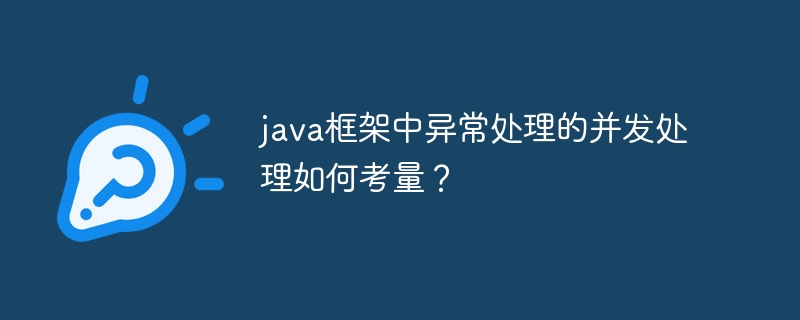在 java 框架中,处理并发异常时应考虑竞态条件、数据不一致和死锁等挑战。为了解决这些挑战,最佳实践包括:1)使用原子更新;2)捕获和记录异常;3)使用异步处理;4)实施事务;5)使用异常边界。通过这些最佳实践,可以确保应用程序的健壮性和稳定性,即使在并发环境中运行也是如此。

Java 框架中异常处理的并发处理考虑
在 Java 框架中,异常处理对于应用程序的健壮性和稳定性至关重要。当应用程序在并发环境中运行时,必须仔细考虑异常处理,以确保应用程序的正确行为和数据完整性。
并发异常处理挑战
立即学习“Java免费学习笔记(深入)”;
最佳实践
为了有效地处理并发异常,请考虑以下最佳实践:
synchronized 关键字或 AtomicInteger 等原子变量,确保对于关键数据进行原子更新,以避免并发更新导致的问题。实战案例
考虑以下并发代码示例:
public class ConcurrencyExample {
private static int count = 0;
public static void main(String[] args) {
Thread thread1 = new Thread(() -> {
for (int i = 0; i < 1000000; i++) {
count++;
}
});
Thread thread2 = new Thread(() -> {
for (int i = 0; i < 1000000; i++) {
count++;
}
});
thread1.start();
thread2.start();
try {
thread1.join();
thread2.join();
System.out.println("Final count: " + count);
} catch (InterruptedException e) {
// 处理中断异常
}
}
}由于对 count 变量的并发更新,此代码可能会产生意外的结果。为了解决此问题,可以使用 synchronized 关键字保护对 count 的更新:
public class ConcurrencyExampleWithLock {
private static int count = 0;
public static void main(String[] args) {
Object lock = new Object();
Thread thread1 = new Thread(() -> {
for (int i = 0; i < 1000000; i++) {
synchronized (lock) {
count++;
}
}
});
Thread thread2 = new Thread(() -> {
for (int i = 0; i < 1000000; i++) {
synchronized (lock) {
count++;
}
}
});
thread1.start();
thread2.start();
try {
thread1.join();
thread2.join();
System.out.println("Final count: " + count);
} catch (InterruptedException e) {
// 处理中断异常
}
}
}通过使用 synchronized,确保对 count 变量的更新是原子的,从而避免了并发问题。
以上就是java框架中异常处理的并发处理如何考量?的详细内容,更多请关注php中文网其它相关文章!

java怎么学习?java怎么入门?java在哪学?java怎么学才快?不用担心,这里为大家提供了java速学教程(入门到精通),有需要的小伙伴保存下载就能学习啦!

Copyright 2014-2025 https://www.php.cn/ All Rights Reserved | php.cn | 湘ICP备2023035733号